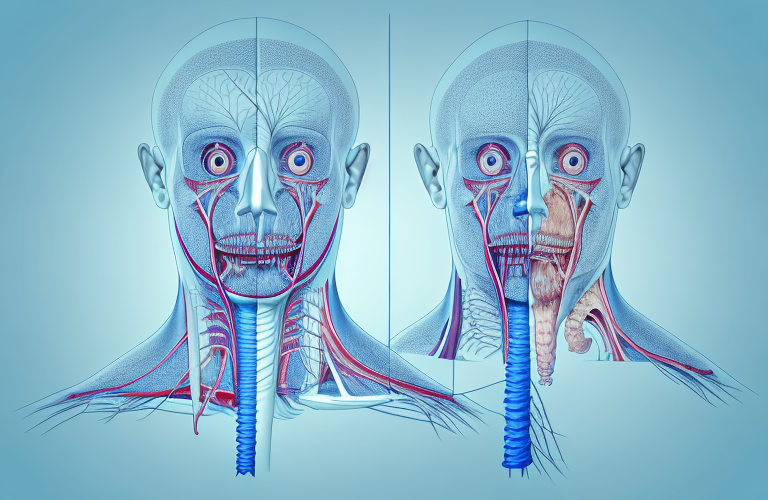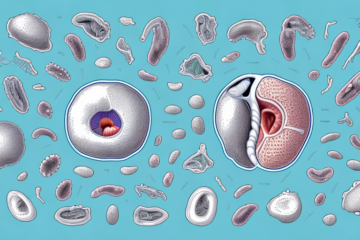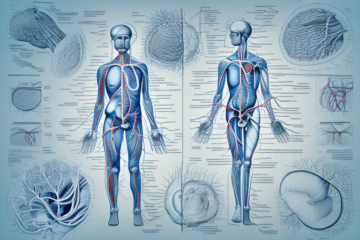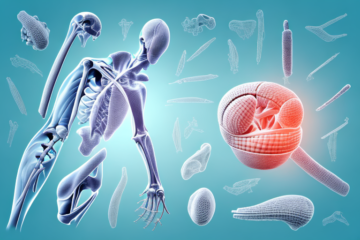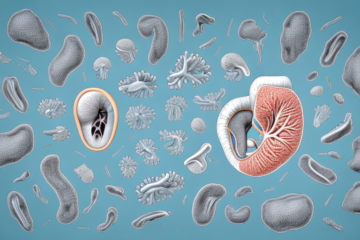The larynx, which is commonly referred to as the voice box, is an essential organ in human anatomy, especially when it comes to speech production. It is located in the neck and helps to route air and food into the correct channels.
What is the Larynx? An Overview
At its most basic, the larynx is a cartilaginous structure that sits between the trachea and the base of the tongue. It is held in place by muscles, tendons and ligaments and is roughly in the shape of a triangular cone. The opening and closing of the vocal cords creates sound during speech or singing.
The larynx also plays a crucial role in protecting the airway during swallowing. The epiglottis, a flap of tissue located at the base of the tongue, closes off the larynx to prevent food or liquid from entering the trachea and lungs. This reflex action is known as the swallowing reflex.
Disorders of the larynx can lead to a variety of symptoms, including hoarseness, difficulty swallowing, and shortness of breath. Common conditions affecting the larynx include laryngitis, vocal cord nodules, and laryngeal cancer. Treatment options range from voice therapy and medication to surgery and radiation therapy, depending on the underlying cause and severity of the condition.
The Importance of the Larynx in Speech Production
The larynx plays a crucial role in speech production. It’s responsible for housing the vocal cords, which vibrate to produce sound. These sounds are then modified by the mouth, nose, and throat before being articulated as speech.
Additionally, the larynx also plays a role in protecting the airway during swallowing. It closes off the trachea to prevent food or liquid from entering the lungs. This reflexive action is known as the swallowing reflex and is essential for preventing choking and aspiration pneumonia.
Structure and Anatomy of the Larynx
The larynx is composed of various cartilages, including the epiglottis, thyroid cartilage, cricoid, and arytenoid cartilages. Of these, the thyroid cartilage is the largest. It gives the larynx its triangular shape and provides crucial protection to the vocal cords.
The larynx also contains muscles, ligaments, and membranes that work together to produce sound. The vocal cords, located within the larynx, are two folds of tissue that vibrate when air passes through them, producing sound waves. The larynx also plays a crucial role in protecting the airway during swallowing, as the epiglottis closes off the larynx to prevent food or liquid from entering the lungs.
How is the Larynx Positioned in the Throat?
The larynx hangs below the root of the tongue and is suspended from muscles and ligaments. It communicates with the pharynx above and the trachea below and is often visible as a prominent protrusion in the neck.
The position of the larynx in the throat is important for speech production. It is situated at the top of the trachea and is responsible for producing sound by vibrating the vocal cords. The larynx also plays a crucial role in protecting the airway during swallowing by closing off the trachea to prevent food or liquid from entering the lungs. Additionally, the larynx is involved in regulating the flow of air in and out of the lungs, which is essential for breathing.
Understanding the Role of Vocal Cords in Voice Production
Vocal cords are responsible for producing sound in the larynx. They are composed of elastic tissue and stretch across the opening of the larynx. The cords can vibrate when air is pushed through them, producing a range of sounds from low to high.
The vocal cords are controlled by muscles in the larynx, which adjust the tension and position of the cords to produce different pitches and tones. The process of voice production also involves the movement of air from the lungs, through the trachea and into the larynx. The shape and size of the larynx, as well as the position of the tongue and lips, also play a role in shaping the sound produced by the vocal cords.
The Four Essential Cartilages of the Larynx
The multiple cartilages that make up the larynx are vital for protecting the airway and ensuring speech production. The thyroid cartilage, cricoid cartilage, epiglottis and arytenoid cartilages all work together to enable a range of vocalization pitches.
The thyroid cartilage, also known as the Adam’s apple, is the largest cartilage in the larynx and provides protection to the vocal cords. The cricoid cartilage, located just below the thyroid cartilage, is a complete ring that provides structural support to the larynx.
The epiglottis is a flap of tissue that prevents food and liquid from entering the airway during swallowing. It is located at the base of the tongue and closes off the larynx when we swallow. The arytenoid cartilages are two small pyramid-shaped cartilages that are responsible for controlling the tension and position of the vocal cords, allowing us to produce different sounds and pitches.
The Function of the Epiglottis in Preventing Choking and Aspiration
The epiglottis is a flap of cartilage that sits above the larynx and prevents food or liquids from entering the trachea during swallowing. It is a critical component of the human body’s basic functions, and issues with the epiglottis’ function can lead to choking and other aspiration risks.
When a person swallows, the epiglottis closes off the trachea, directing food and liquids down the esophagus and into the stomach. However, certain medical conditions or injuries can affect the epiglottis’ ability to function properly, leading to aspiration pneumonia or choking. In some cases, surgery may be necessary to repair or replace the epiglottis. It is important to seek medical attention if you experience difficulty swallowing or breathing, as these symptoms may indicate a problem with the epiglottis.
Common Disorders that Affect the Larynx
There are several disorders that may affect the larynx. Laryngitis is one of the most common of these, and it is characterized by inflammation of the larynx, which can lead to hoarseness and difficulty speaking, among other symptoms. Vocal cord nodules are another common condition that may require treatment for recovery.
Another disorder that can affect the larynx is laryngeal cancer. This type of cancer can develop in the tissues of the larynx and can cause difficulty in breathing, swallowing, and speaking. Treatment for laryngeal cancer may include surgery, radiation therapy, and chemotherapy.
Reflux laryngitis is also a common disorder that affects the larynx. This condition occurs when stomach acid flows back into the throat, causing irritation and inflammation of the larynx. Symptoms of reflux laryngitis include hoarseness, chronic cough, and a feeling of a lump in the throat. Treatment for reflux laryngitis may include lifestyle changes, such as avoiding spicy foods and alcohol, and medications to reduce stomach acid.
Causes and Treatment of Laryngitis
Laryngitis can be caused by viral or bacterial infections or from vocal overuse and strain. Treatment for the condition often involves rest, hydration, and avoiding irritants such as smoking or dry air. In severe cases, medications to reduce inflammation may be prescribed.
It is important to note that chronic laryngitis can also be caused by gastroesophageal reflux disease (GERD) or allergies. In these cases, treating the underlying condition is necessary to alleviate the symptoms of laryngitis.
In addition to medical treatment, there are also natural remedies that can help soothe the throat and reduce inflammation. These include drinking warm liquids like tea with honey, gargling with salt water, and using a humidifier to add moisture to the air.
Symptoms and Management of Vocal Cord Nodules
Vocal cord nodules are small, benign tissue growths on the vocal cords. They can develop due to vocal overuse and strain and can lead to hoarseness and voice fatigue. Treatment for vocal cord nodules involves rest, therapy, and in some severe cases, may require surgery.
It is important to note that prevention is key when it comes to vocal cord nodules. This can be achieved by practicing good vocal hygiene, such as staying hydrated, avoiding smoking and excessive alcohol consumption, and using proper breathing techniques when speaking or singing. Additionally, seeking treatment for any underlying conditions, such as acid reflux or allergies, can also help prevent the development of vocal cord nodules.
The Connection Between Acid Reflux and Laryngeal Cancer
Acid reflux is a common condition that can cause irritation and inflammation in the larynx. Over time, this irritation may lead to precancerous and cancerous changes in the larynx. It’s important to manage acid reflux symptoms and see a doctor if symptoms persist, as they may signify a more severe underlying issue.
Some common symptoms of acid reflux include heartburn, regurgitation, and difficulty swallowing. Lifestyle changes such as avoiding trigger foods, losing weight, and quitting smoking can help manage symptoms. In some cases, medication or surgery may be necessary to treat acid reflux and prevent further damage to the larynx. It’s important to talk to your doctor about any persistent symptoms and to follow their recommended treatment plan.
Tips for Maintaining a Healthy Voice
To maintain a healthy voice, it is essential to stay hydrated, rest your voice regularly, and avoid any irritants that may cause damage to the larynx such as smoking, shouting, or extreme vocal use. Vocal exercises and warm-ups may also help prevent vocal strain and injury.
In addition to these tips, it is important to pay attention to your overall health and well-being. Stress and anxiety can also affect your voice, so finding ways to manage and reduce stress levels can be beneficial. Additionally, getting enough sleep and maintaining a healthy diet can also contribute to a healthy voice.
How to Protect Your Larynx When Singing or Public Speaking
When singing or public speaking, it is crucial to avoid overuse and to utilize proper breathing techniques. This helps prevent undue strain on the larynx and promotes good vocal cord health over time. Adequate hydration and warming up the voice before use are also essential for optimal vocal performance.
In addition to these basic tips, there are other ways to protect your larynx when using your voice extensively. One effective method is to use a microphone, which can help reduce the strain on your vocal cords by amplifying your voice. Another helpful technique is to avoid speaking or singing in noisy environments, as this can cause you to strain your voice in order to be heard. Finally, it is important to take breaks and rest your voice when you feel fatigued or notice any discomfort in your throat or larynx.
The Future of Research on Laryngeal Disorders
As medicine and surgical techniques continue to advance, research, and treatments for various laryngeal disorders are improving. Scientific advances may help better identify significant risk factors or develop new minimally invasive surgical techniques that reduce complications or improve recovery times.
In conclusion, the larynx plays a critical role in human conversation, and it’s vital that we appreciate and protect this significant body part to maintain optimal vocal health over time. Whether by rest, hydration, or proper technique use, everyone can do their part to ensure their larynx remains healthy and functional throughout their lifetime.
One area of research that shows promise is the use of stem cells to regenerate damaged laryngeal tissue. This could potentially lead to more effective treatments for conditions such as vocal cord paralysis or scarring. Additionally, advancements in imaging technology may allow for earlier detection and diagnosis of laryngeal disorders, leading to better outcomes for patients.
Another area of focus is the impact of environmental factors on laryngeal health. Studies are being conducted to determine the effects of air pollution, smoking, and other environmental factors on the larynx. This research may lead to new preventative measures or treatments for individuals at risk for laryngeal disorders due to environmental exposure.

